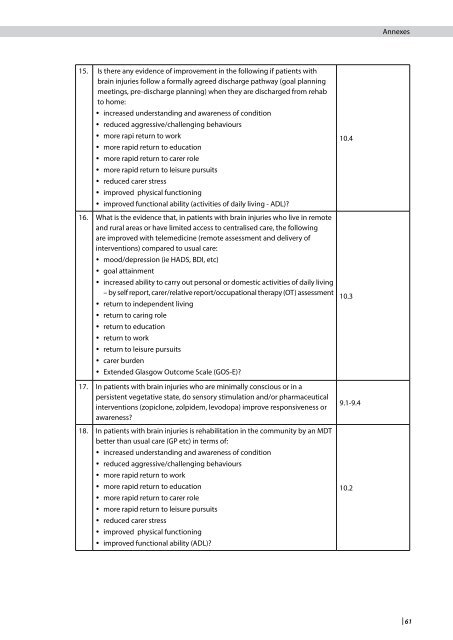sign130
sign130
sign130
You also want an ePaper? Increase the reach of your titles
YUMPU automatically turns print PDFs into web optimized ePapers that Google loves.
15. Is there any evidence of improvement in the following if patients with<br />
brain injuries follow a formally agreed discharge pathway (goal planning<br />
meetings, pre-discharge planning) when they are discharged from rehab<br />
to home:<br />
y increased understanding and awareness of condition<br />
y reduced aggressive/challenging behaviours<br />
y more rapi return to work<br />
y more rapid return to education<br />
y more rapid return to carer role<br />
y more rapid return to leisure pursuits<br />
y reduced carer stress<br />
y improved physical functioning<br />
y improved functional ability (activities of daily living - ADL)?<br />
16. What is the evidence that, in patients with brain injuries who live in remote<br />
and rural areas or have limited access to centralised care, the following<br />
are improved with telemedicine (remote assessment and delivery of<br />
interventions) compared to usual care:<br />
y mood/depression (ie HADS, BDI, etc)<br />
y goal attainment<br />
y increased ability to carry out personal or domestic activities of daily living<br />
– by self report, carer/relative report/occupational therapy (OT) assessment<br />
y return to independent living<br />
y return to caring role<br />
y return to education<br />
y return to work<br />
y return to leisure pursuits<br />
y carer burden<br />
y Extended Glasgow Outcome Scale (GOS-E)?<br />
17. In patients with brain injuries who are minimally conscious or in a<br />
persistent vegetative state, do sensory stimulation and/or pharmaceutical<br />
interventions (zopiclone, zolpidem, levodopa) improve responsiveness or<br />
awareness?<br />
18. In patients with brain injuries is rehabilitation in the community by an MDT<br />
better than usual care (GP etc) in terms of:<br />
y increased understanding and awareness of condition<br />
y reduced aggressive/challenging behaviours<br />
y more rapid return to work<br />
y more rapid return to education<br />
y more rapid return to carer role<br />
y more rapid return to leisure pursuits<br />
y reduced carer stress<br />
y improved physical functioning<br />
y improved functional ability (ADL)?<br />
10.4<br />
10.3<br />
9.1-9.4<br />
10.2<br />
Annexes<br />
| 61


